
New report shows construction executives and frontline employees may not agree on tech stack capabilities
Did you miss our previous article…
https://www.clarkeconstructioncreations.com/?p=1313


New report shows construction executives and frontline employees may not agree on tech stack capabilities
Did you miss our previous article…
https://www.clarkeconstructioncreations.com/?p=1313


The construction industry isn’t short on data. In fact, every project creates massive amounts of construction data from design and planning to turnover and beyond. Yet one of the most significant challenges faced by stakeholders is accessibility to the most important data right when it’s needed. This step is critical to uncovering insights and powering better decision-making.
So how do we make critical project data accessible through the entire AEC lifecycle to the teams and individuals who need it most? Lauren Collier, Business Leader Project Technology/VDC at SSOE Group, and Sunny Manku, Technical Solutions Executive at Autodesk explore this very question in the Autodesk University 2021 session, Data in the AEC Lifecycle: Using Data to Better Connect AECO Stakeholders.
We’ve gathered highlights from their session, including why a data initiative—and subsequently a unified platform—is paramount, the benefits of gathering data throughout the project lifecycle, how to best prepare your firm to succeed at data analysis, and more. Let’s explore their recommendations for making the most of data through the entire AEC lifecycle.
To make data accessible and meaningful to decision-makers, you first must understand the value of capturing project data in a unified platform.
For starters, what is a “unified platform”? A unified platform connects people, data, and workflows together throughout each stage of the project lifecycle for comprehensive construction project management.
The next question: What makes a unified platform so powerful? It’s the technology that connects with and moves your strategy forward. As Lauren explains, “ Technology shouldn’t just be the driving force to your strategy. Technology should be that accelerator. It’s that integrator. It’s the glue that allows you to really get your strategic initiatives done.”
“Technology shouldn’t just be the driving force to your strategy. Technology should be that accelerator.”
Lauren Collier, Business Leader Project Technology/VDC, SSOE Group
A unified platform also provides a single source of truth to rely on. Often referred to as a common data environment (CDE), this isn’t merely a list of APIs connected to a SaaS solution. Instead, it’s a type of construction management software that provides access to data and tools that designers, engineers, and builders need. Furthermore, a unified platform enables third parties and customers to create and share their own purpose-built solutions whenever, wherever, and however they need.
When data lives in one place, you have the ability to break it down across design, planning, building, and operating. As Sunny puts it, this opens up “an opportunity for all stakeholders, regardless of what they’re doing in the project, to be able to collaborate effectively in one place.” Stakeholders not only have the confidence that data is living in one place, but they can also pay attention to version controls and review past decisions made on the project in earlier stages.
A unified platform should play an active role in coordinating how products work together, rather than just allowing you to exchange data with other applications. The data exchanged must flow seamlessly and bidirectionally across all capabilities within the platform. By doing so, users receive a productive, intuitive experience that drives much more effective workflows.
Cost certainty is an important part of setting expectations and delivering a great project outcome. By picking the right unified platform, you’ll find budgets are easier to manage because you’re more effectively connecting cost activities to schedule with real-time project data. When you stay on schedule and within budget, it’s no surprise that customers are happier and open to working together on more projects.
In addition, maintaining budgets and schedules is critical to maximizing profit margins. However, the construction industry is no stranger to delays, rework, and blown budgets. A recent Dodge Data & Analytics research report revealed that 66% of general contractors are carrying added costs from overtime shifts on at least three-quarters of their projects due to schedule slippage, with 50% of them needing to extend the project end date. Bad construction data is at least partly to blame for these statistics and adds up to $1.85 trillion in cost impacts to the industry globally.
Construction data and technology both play major roles in maintaining budgets, schedules, and customer satisfaction.
Construction firms need a solid data strategy to overcome the impacts of bad data. In the Harnessing the Data Advantage in Construction report from Autodesk and FMI, proper data management is identified as being a significant competitive advantage in today’s fast-paced market. You can download the report for free to discover actionable steps for implementing a data strategy and access the useful checklist with the most most important steps.
Construction data and technology both play major roles in maintaining budgets, schedules, and customer satisfaction. Lauren elaborates on how data management fits into SSOE’s efforts, “We are more successful in our design effort and our value proposition to the client if we can coordinate that design, construction, and execution with no surprises. That’s really why [our] data initiative became very important to us.” This level of accessibility and coordination must be available at all phases of the construction lifecycle: designing, planning, building, and operating.
To help avoid unwelcome surprises, the Schedule tool in Autodesk Build is worth checking out. This tool allows teams to collaborate, connect, and integrate with the most up-to-date schedule. Everyone has access to real-time information around the master schedule data in the field to work together seamlessly and efficiently. All of which helps prevent cost overruns due to schedule disruptions.
Of course, one of the main benefits of a good data management strategy is a more confident analysis of the numbers, which leads to smarter decisions. SSOE uses Autodesk Construction Cloud products to provide greater context for all stakeholders and increase collaboration between design and construction. Hence, why Lauren is presenting on this popular topic.
Her team worked to better understand the potential for analysis through data architecture mapping. This exercise made the team realize they wanted to measure key performance indicators by connecting and consuming data. To do so, they decided to bring their data into a single source of truth through investment in Autodesk’s unified platform. This initiative also reflects SSOE’s commitment to respect in the workplace by fostering a culture of personal accountability.
For SSOE, increasing respect and accountability is about reducing waste and increasing collaboration. “It allows for the whole team to kind of come together. It’s not these wasteful silos [sic] anymore,” explains Lauren, “It really is, ‘this is the place I go. This is the place I can consume information. This is the place I communicate. And this is the place that I report out.’”
Ultimately, making construction data accessible to AECO stakeholders really comes down to simplification. Firms often have multiple, complex systems producing and storing data. These systems may run effectively in the background but impede collaboration and analysis through their lack of connectivity, and thus a lack of practical usability. To better prepare your infrastructure for lifecycle data analysis success, Lauren recommends being selective about the tools and integrations you select to keep your tech stack simple and efficient.
From there, bring your internal and client resources into the picture. SSOE has leveraged its internal technology staff as well as clients in the digitization process. “Our clients have been very informative in this digitization process because there’s data they want to consume downstream. The easier that we can make that data easily accessible to them, we become a more valued partner.”
As you work with internal and external resources, consider which data skills you’ll need to prioritize. Having a strategy for upskilling your workforce will help to get more out of data and foster a more data-driven culture. For insights into what roles construction leaders expect to grow in importance, this article sheds some light.
The most effective construction software platforms quickly and easily connect decision-makers to the data they need the most, when and where they need it. A unified platform is the first and most crucial step to data accessibility across the entire AECO lifecycle. From there, you can increase your results by implementing a data management strategy and encouraging your firm to analyze data by preparing your infrastructure and talent.
If you need help finding the right unified platform, our team would be happy to help you unpack that. You can contact us here.
The post Construction Data: How to Make it Valuable & Accessible to AECO Stakeholders appeared first on Digital Builder.
The phrase ‘construction data analytics’ may be enough to make your eyes glaze over. But every day on construction sites, teams are coordinating hundreds of subcontractors, managing thousands of open issues, and navigating constant onsite changes. As construction projects continue to grow in complexity, teams need the right insights to minimize risk and improve quality and safety initiatives.
Furthermore, the digitization of construction processes and the use of mobile devices on jobsites means more data is being captured than ever before. But 95% of that data is going unused by construction and engineering firms, according to FMI.
Data analytics are no longer a nice to have – they are essential to providing the right insights to improve quality and reduce risk. When teams are equipped with the right information and data, they can improve decision making and project outcomes. It’s the reason we built powerful data analytics capabilities into our Insight product for both Autodesk Construction Cloud unified platform and BIM 360.
Let’s explore four capabilities within Insight that empowers teams to leverage insights to minimize risks.
Within Insight, anyone on the project can view a summary of critical and actionable information through preset and customizable dashboards. These dashboards can be easily configured by adding or removing cards from the Card Library including third party partner cards, as well as dragging and dropping cards to customize views. Additionally, users can share any custom dashboards with other team members based on role, company, or specific users.
Dashboards are created on both a project and cross project level. From within a project, you can see present dashboards for Quality, Safety, Project Controls, Design, and Risk (if your project leverages Construction IQ).
From the Executive Overview view within Insight, executives can view cross project dashboards to make more informed business decisions and gain visibility into overall risk assessment. Through these dashboards, executives can view risk levels of individual projects by location as well as drill down to see patterns of risk over time. By analyzing patterns, executives can optimize processes across similar projects.
These dashboards allow you to easily visualize project progress and determine which areas of the project may need the most attention.
“The ability to identify risks across projects enables us to prioritize opportunities for improvement and reduce risk to future projects.” – Anthony Colonna, Senior Vice President, Skanska
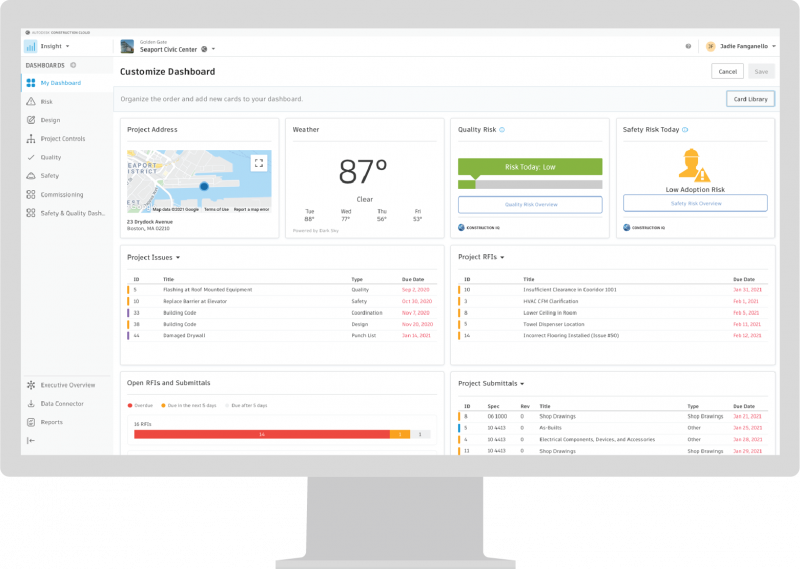
Reporting is a necessary but often time-consuming project activity. Within Insight, we aim to make reporting easier. By having a centralized place to create, schedule, and share reports, teams save a lot of time and always know where to find the most current information.
Within the Reports tool you will find a series of reporting options including Issue, RFI, and Submittal summary and detail reports. Reports are easily customizable and can be grouped by or filtered to fit your specific needs. Finally, these reports can be scheduled on a reoccurring basis and shared with other team members based on user, company, or role.
“The reporting and dashboarding features in Construction IQ provide clear and concise feedback on the various project critical data streams. This information enables our project management teams to make the right decisions more rapidly and effectively,” says Michael Murphy, Digital Construction Operations Manager at BAM Ireland. “With these features, we’re having less reactive conversations with more emphasis on KPIs that can drive continual improvement. The simple visualization of the challenge or the issue alone helps us bring that focus.”
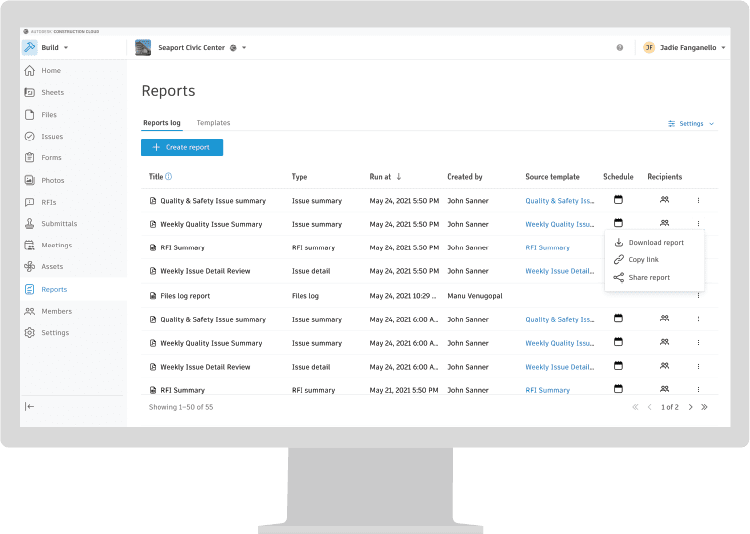
Through a single click, Data Connector allows teams to quickly extract project data from both the Autodesk Construction Cloud platform or BIM 360 for customized use in other robust business intelligence tools. You can also easily schedule extractions and sync them directly to Power BI through the Power BI Connector. And to make this a full circle connection, you can even use the Power BI partner card to then view those Power BI dashboards directly within an Insight dashboard and share it with the rest of the project team.
We also created easy to set up Power BI templates so that you can quickly start leveraging your data and customizing dashboards to see exactly what you want.
The Data Connector saves teams time and money by giving them a tool to extract data without needing expensive APIs or custom coding in addition to improving data visualizations to inform better business decisions.
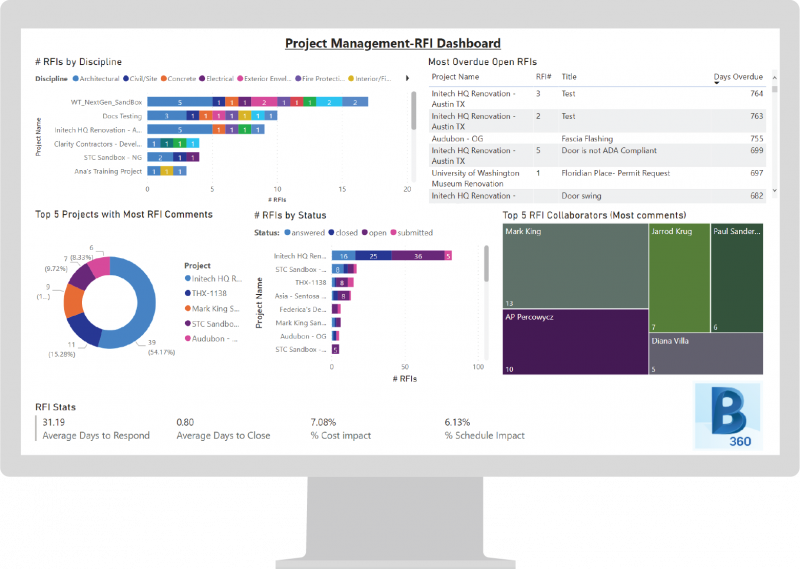
Construction IQ is a machine learning based capability that delivers risk analysis of quality, safety, design, and project controls data from both Autodesk Construction Cloud platform and BIM 360 projects. Construction IQ moves beyond the traditional concept of static data and takes prediction to the next level with assistive, action-based intelligence. The capability allows users to:
Most importantly, you do not have to do any extra work to get the benefit of Construction IQ. All data captured during construction is continuously and automatically analyzed.
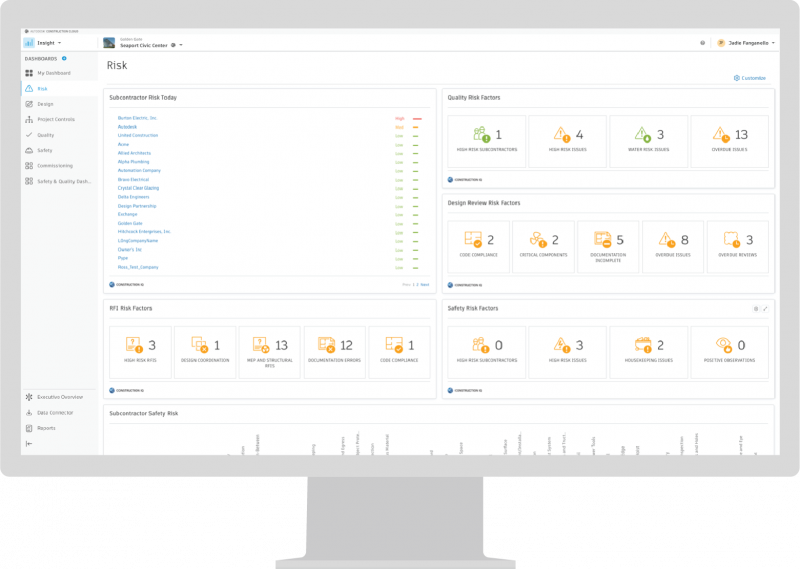
Get more out of your project data with Insight for the Autodesk Construction Cloud platform and BIM 360. Learn more here.
The post How to Manage Project Risk with Construction Data Analytics appeared first on Digital Builder.
Did you miss our previous article…
https://www.clarkeconstructioncreations.com/?p=1298

Axalta Coating Systems Ltd are a leading global coatings provider dedicated to the development, manufacturing, delivery, and service of liquid and powder coatings, with their headquarters in Philadelphia, USA. With over 150 years of experience in the coatings industry, they provide their customers with innovative, colourful and sustainable solutions.
Predominantly developing and manufacturing coatings for light and commercial vehicles, industrial and refinish applications; Axalta embraces the latest trends alongside emerging technology and systems to deliver the finest coatings to more than 100,000 customers across the globe. With 46 manufacturing centres across the world, 28 laboratories and a presence in over 130 countries, the team at Axalta are constantly looking at news ways to push boundaries.
Marco Schuh, BIM Manager at Axalta, has worked in the architecture, engineering and construction industry for the last 20 years. In his various roles, Marco has witnessed the vast expansion of computer-aided design first-hand and has seen Business Information Modelling (BIM) use and demand rapidly increase. “For the last five years, I have been focusing on cloud-based project management practices in a BIM environment, so I have seen the application and the technology grow too,” says Marco.
In 2019, Axalta’s plant engineering subsidiary business based in Wuppertal, Germany began exploring how they could move some of their local project data from a local server into the cloud. The team wanted to be able to host and store project documentation centrally in a secure environment but also to learn more about how they could improve, implement, and embed digital workflows for this business unit to aid communication and collaboration.

With many different document management practices happening on the ground for the plant engineering team, ensuring standardised document management processes were implemented smoothly was very important. Alongside this, the team also needed to find a solution that allowed everyone to access the documents they needed wherever, and whenever they needed them.
Working in a plant environment with tight timescales means that the team at Axalta cannot afford to lose project time due to poor communication because of missing project data. The team were already using a server solution for internal documentation, but it limited their ability to successfully access, track and collaborate on documents in a transparent way.
After a period of exploration, Axalta concluded that Autodesk Construction Cloud’s BIM 360 solution was the right technology for Axalta’s needs with a focus on improving communication. To implement the solution successfully and smoothly, Marco partnered with Autodesk’s customer success team and their local reseller partner, Mensch und Maschine Deutschland. It was crucial that the team at Axalta were able to move their interdisciplinary project data into the cloud environment in a seamless way, minimising any disruption to ongoing live projects.
“Our projects are time-critical, so we need smooth, transparent, clear communication and filing to know where project data was stored as we transitioned from our previous system to BIM 360,” Marco reflects.
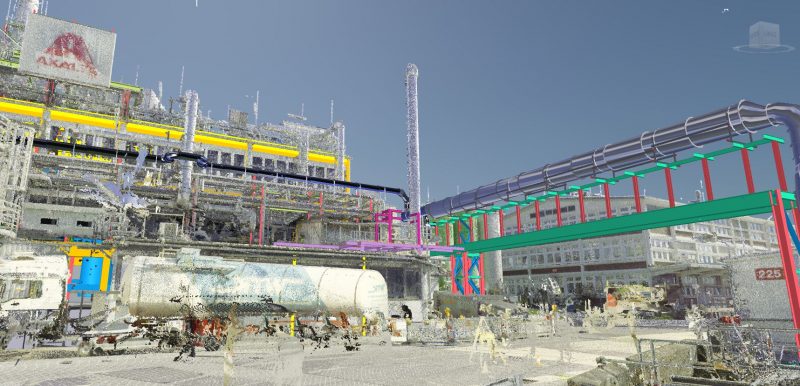
The team at Axalta were aware of the long-term negative impacts that could arise from disruption to ongoing projects, so they created a comprehensive transition plan. The plan, which spanned a 12-month period, involved an elaborated transition process which included a testing and a migration phase. This happened in parallel with Axalta’s ongoing day-to-day regular processes, so the team were managing two ways of working at once. Working in this way helped to minimise any interruptions or delays to ongoing work and allowed the team plenty of time to understand and prepare employees for new ways of working within the team.
To get started, the team at Axalta began their journey with BIM 360 on a large collaborative project which involved several stakeholders – many of which were not directly located on site at Axalta’s plant facility. To ensure all the external collaborators and partners were safely and comprehensively introduced to the solution and the new ways of working, Marco conducted introductory sessions on site. As well as this, Marco and the team created an internal handbook for project team members to use with a complete overview of the BIM 360 project workflows that would be rolled out.
“We worked closely with the team at Autodesk to ensure we transitioned successfully, and this included bi-monthly calls with tech champions, mentorship on workflows for these champions, feedback sessions with Autodesk’s product team as well as ongoing communication on outcome-focused goals,” says Marco.
Internal plant maintenance projects and construction projects for new plants began using BIM 360 for document management and digital workflows. The team began with a focus on document management practices but soon expanded into using other capabilities BIM 360 had to offer. Naming conventions and folder structures were the first areas the team focused on as well as supporting the Computer Aided Design (CAD) teams with how they could digitalise and integrate their processes with BIM 360. This involved training sessions and one-to-one support by Marco as a BIM 360 expert.
“We began exploring the functionality that allowed our teams to make notes and annotations onto our models in BIM 360 which increased accountability, transparency and communication immensely,” says Marco. “Annotating directly on the model meant that we minimised the chance of anything being missed when moving between different platforms and systems.” The team have also looked at what other digital workflows they could expand to use such as issues tracking.
For the team at Axalta, using BIM 360 as their common data environment meant internal communication on projects improved significantly. Marco says: “BIM 360 gives us a single source of truth, transparency between all project stakeholders, and accessibility from anywhere meaning we’re all much better informed during a live project than we were before we started using BIM 360.” For the team, quality has increased dramatically as all project team members can be sure they are accessing one single source of truth. As well as this, standardising the team’s approach to document control and modelling has meant that all project collaborators can be sure they have the most up-to-date and accurate information they need when making important project decisions related to their tasks and activities.
After a year of testing and using BIM 360 in the plant engineering subsidiary business, the use of BIM 360 is being explored by some of Axalta’s manufacturing, construction, and engineering departments in their locations in Germany.
“Looking to the future, we plan on expanding our use of BIM 360 in plant and engineering even more,” affirms Marco. “We’ve also began integrating further technology into BIM 360 such as our laser scanning workflows and we’re looking to use the BIM 360 Coordinate feature to improve our model coordination processes,” remarks Marco.
For the team at Axalta, implementing BIM 360 to create robust document management processes, digitalising workflows and capturing project progress information in a BIM environment has not only improved team collaboration but delivered better project outcomes. “The most popular features in BIM 360 that our teams are using are the, project management, model coordination and issues management workflows as well as the powerful approval workflows for reviews within document management capabilities which reflects how the quality of our projects are improving through the use of BIM 360,” says Marco. Looking to the future, implementing the use of BIM 360 on more and more projects is the focus for the team as well as harnessing data for better project insights to drive decision-making across the business.
The post Scaling for Success in the Plant and Manufacturing Industry Through Standardised Ways of Working appeared first on Digital Builder.
Did you miss our previous article…
https://www.clarkeconstructioncreations.com/?p=1291


The importance of hard work and thinking big cannot be understated, especially in the world of modern design and construction. These are the very things that lead to growth, innovation, and career success, which is why it’s essential that we strive to embody these traits in our day-to-day lives.
One person who’s doing just that is Justin Lipsey, VDC Technical Leader at SSOE.
Justin started his construction career as a plumbing engineer, and in 2018, proactively made the transition to a more tech-focused role in VDC. He’s achieved quite a lot in just over three years within the VDC realm, including winning SSOE’s Founder’s Award and landing a speaking engagement at Autodesk University.
Justin credits his accomplishments to positive thinking, dedication, and of course, hard work.
We recently caught up with him to discuss his construction journey thus far, as well as what’s next.
SSOE is an AEC firm specializing mostly in the “engineering” portion of that AEC acronym. We’ve been around for 70-plus years and have business units that touch pretty much every facet of the industry. So, we range from semiconductors all the way to educational projects.
When working at SSOE, you’re actually able to interface with anything you would like. There are loads of opportunities. In my case, I have over a decade of experience as a plumbing designer/engineer. I was in the automotive and manufacturing business unit, and my specialty was siphonic storm drains.
But then I switched over to technology. Now, my role is with the Project Technology department and I’ve been here just over three years. I specialize in all things BIM 360 and ACC (Autodesk Construction Cloud).
I started off just by volunteering and training with pilot projects. And two and a half years later, many of my coworkers call me “BIM Three Lipsey”.
I’ve always been into technology and computers, and I like being creative. But sometimes design and engineering projects aren’t creative at all, especially the types of projects I was working on.
So I started looking for ways where I could get into tech but still remain in my industry. A VDC rotation slot happened to open up, and at that time I didn’t really know a great deal about VDC. I just had a very broad idea of what it was.
But I took the leap, and that spiraled into registering point cloud data, laser scanner operation training, and all things reality capture technology. I learned really quickly and I get to work with developers now. I can really say that I’m passionate about this work.
I also got to go to AU in 2019 and just sat with the Forge devs for an entire day. I learned so much just by sitting next to them, talking to people’s managers, and soaking it all up. So VDC led me into the world of construction technology.
The way I see it, technology is like the wild wild west right now. Depending on your job title, you get to make your salary—you get to decide on your duties and tasks. It’s amazing.
About a year and a half ago, I wrote down this list of goals. It included things like speaking at AU (Autodesk University) and winning a Founder’s Award, one of our most prestigious awards at SSOE.
I’m proud to say that I hit those goals in about 6 months. I was given the opportunity to speak at the virtual AU last year, where I discussed the topic of AEC product ownership.
There was also the Founder’s Award, which was given to the project team who developed training materials to support the rollout of BIM 360. Before the pandemic hit, we were piloting BIM 360 and trying to understand how to best roll it out. Then COVID happened and there were infrastructure issues immediately. That’s when we made the quick decision that every new project going forward starting January of this year would be in BIM 360.
To make it happen, we needed to develop training materials. I was afforded the ability to utilize all of the beautiful music equipment I have collected over the years and my limited knowledge of video creation and editing. I purchased an iPad app, watched a few YouTube videos, and was able to create over 20 customized training videos for BIM 360. Our team also created a SharePoint site to house all of our training content and other supplementary information. To-date, we have uploaded over 150 pages of tips and tricks, knowledge base articles, and quick reference guides
“One of the most rewarding parts of my job is when I finally get things to click for someone, and they say, ‘Oh, I understand that now! And I’ll share this with my team.’”
Justin Lipsey, VDC Technical Leader, SSOE Group
There were a whole bunch of people who contributed to our training content, so I can’t take all of the credit. Our developers were able to whip up this automation, despite some limitations within the API for BIM 360. They did a bunch of workarounds to get a lot of “ease-of-use” functions out to our users.
I’m proud of all of that. I knocked all my goals out of the park and I think it’s just the power of manifestation—writing things down, and looking at it every day.
Honestly, I think the future is going to be more focused on data analytics, as well as innovation, research, and development.
I am also hoping for more product ownership because, over the next five years, we’re going to need a team of people who understand computational design, algorithms, APIs—all that fun stuff. We’re trying to build that team of people right now and we’re looking to leverage Power BI and dashboarding. We’re trying to figure out how to harvest the data from BIM 360 and our new ERP Microsoft Dynamics to gain the insights we need to make better business decisions. We also want to better visualize that kind of information in a palatable way for our users.
Right now, VDC is more of a manual process. I interface with project teams. I’m doing a lot of the training and tons of research and documentation, but I believe that the future would be similar to how Revit developed. Now, you have Revit power users who do a majority of what a BIM manager used to do 10 or 15 years ago, managing templates, setting up models, etc. This allows BIM managers to focus on more high-level important coordination items.
In the future, it should be the same for VDC. Research and development should come from operations. They should be telling us what they need, what they want, and VDC performs the analysis and evaluates how to best fit it into our tech stack. Then empower them through the use of data to visualize the end goal.
There’s also the learning aspect to the job. BIM 360 and ACC Build have the Insight module, and we’re really trying to utilize that. I think a big part of the future is learning how to use all this data and figure out how to apply it to upcoming projects. Then we can really handpick our clients and projects. That way, we’ll be more profitable and provide the most value.
I also think that product owners and managers will become more prevalent in our industry. Technically, I’m a product owner of BIM 360 right now. We have this amazing automation process that our developers came up with, where you can create a new project in our ERP system, and it spins up a BIM 360 project. It also spins up an Outlook group so they can track their project email. As a product owner, I helped connect the developers to the business by defining what would be the most valuable automation for our project teams.
Being a part of the BIM 360 team, I interface a lot with our users and take feedback to the devs and give them improvement ideas for that automation. And in my eyes, that’s the future. If more of our VDC folks would learn the skills needed for product management and the human side of technology, I would welcome that.
We’re in this digital transformation phase where we’re no longer attempting to bend technology to fit our processes, we’re revising our project execution processes to fit the technology. This can be a challenging concept for people who have been doing something a certain way for 20 or 30 years.
But one of the most rewarding parts of my job is when I finally get things to click for someone, and they say, “Oh, I understand that now! And I’ll share this with my team.”
This is what happened with BIM 360. It helps us collaborate a lot better, and certain processes are streamlined now.
Our CEO has set a goal for 2025 to improve efficiencies and productivity by 50% organization-wide. This is a large undertaking for us, and BIM 360 was just the beginning. ACC Build is being piloted now on a few projects and we are looking for ways to utilize the new features in the platform. We have partnerships with Autodesk, Microsoft, and Cintoo that we are looking to leverage and assist in the development of solutions that progress our strategic business goals, and advance our industry. I am keeping an eye on a few game changing companies like AVAIL and Bridgit in hopes of partnering with them one day as well. But most importantly for us, automation is the key. Whether it’s through Dynamo, Power Automate, or developing something custom, we are looking for ways to streamline our project execution processes with automation and generative design. Last but not least, we are attempting to break down the silos between design firms, fabricators, and GC’s through the use of Fab Parts in Revit.
Something I try to instill in my son is that if you put your head down, work hard, and are respectful, opportunities will present themselves. I have an associates degree in CAD Technology, but I worked extremely hard to get to where I am today. So to all future technologists, don’t focus on getting fancy acronyms that you can add on after your name. Work hard, stay curious, dream big, and build your future without limitations in mind.
The post Behind the Build: Interview with Justin Lipsey, VDC Technical Leader, SSOE appeared first on Digital Builder.
Did you miss our previous article…
https://www.clarkeconstructioncreations.com/?p=1288


In any workplace, good decisions drive good outcomes. In construction, those outcomes can vary from staying on schedule to facing major time and cost over-runs.
But decision makers are now contending with more complex projects and shorter timelines than ever before.
In fact, four in five APAC construction professionals say schedule compression is fueling the need to make more rapid decisions, according to Autodesk Construction Cloud’s new Harnessing The Data Advantage In Construction report.
Autodesk partnered with FMI Global to survey more than 3,900 construction industry stakeholders, including more than 500 across Australia, New Zealand, Singapore, India, and Hong Kong, to understand how their approach to data was propelling them forward – or holding them back.
And the single biggest factor interfering with making good decisions? The lack of reliable data.
The research revealed vastly different approaches to data strategy, but what’s almost universal is the fact that more data is being generated and collected than ever before. In fact, most project managers and field supervisors report spending two to three days a week collecting and managing the ever-increasing torrents of data.
A big factor in this workload is the multiple channels from which data must be collected, and the numerous formats it arrives in. As one subcontractor told us, “The usual way in which most construction companies operate is a lot of decentralised information.
“We create 2D designs, spreadsheets, PDFs and a whole range of different file types and formats. This is very hard to manage.”
Not only are many streams of data unwieldy – they can also be tainted.
For the average construction firm, almost 40% of the data they are collecting is bad – inaccurate, incomplete, inconsistent or untimely.
For data to produce valuable insights and drive better project outcomes, it needs to be readily:
Worryingly, just one in eight construction professionals believe that most of their data meets this definition. This doesn’t just undermine confidence in data-driven decision-making; it undermines projects too.
Industry data indicates that for every $1 billion of revenue earned by a contractor, the total cost of poor decisions driven by bad data could be as high as $165 million. In fact, it is estimated that bad data is responsible for 14% of all construction rework.
That means bad data costs the construction industry an estimated A$2.49 trillion in 2020. And that’s before we count:
Despite the vast increases in data flows, barely one in 10 construction professionals report always incorporating project data into their decision making. Most do it sometimes, at best.
These concerns over data quality are why the companies that are reporting getting the most out of their data have formal plans in place to ensure the quality of their data.
“We have invested a lot of time and money ensuring the integrity of our data. Otherwise, it will all be a terrible waste,” one told us.
Another contractor explained, “We want the data to work for us and not against us. If you have bad data, the results will be bad, no matter how good the process is.”
Among the chief challenges faced in using the data being collected are:
Overcoming this requires both process and people solutions.
On the process side, for instance, replacing non-collaborative digital channels such as email with cloud-based, construction specific technology can ensure data is collected accurately and easily accessible.
Underpinning all of this is a firmly mapped out data strategy. Such a strategy must cover which data is the most valuable to a given team, and how it can be made reliable and accessible.
Having this not only helps you ensure your processes and tools are fit for purpose – it also helps bring the people you need up to speed.
A subcontractor in the mechanical, electrical and plumbing sector told us, ”Everything is centred on our information being iterative and creating bidirectional workflows with BIM software to drive commissioning activities out on-site.
“That means that we can actually collect data from the field and format it back into the model. We’re getting consistency through construction documentation – and consistency breeds quality.”
Our research clearly shows the impact of trying to make decisions with bad data – the average company reports that it results in poor decisions 38% of the time.
On the other hand, those companies that have nailed their data strategy say it is driving fewer budget overruns, fewer missed schedules and fewer safety incidents.
By managing data effectively from collection to access, these are the companies unlocking its value and moving to the next level, where nothing is left to chance.
An integrated digital approach allows them to see all of the dependencies on a construction site and review the project schedule for potential risks. They can see how a change order might affect the project’s critical path, and re-prioritize accordingly.
Despite this, one in three APAC construction firms without a data strategy say the cost and resourcing required for a data strategy is holding them back.
It’s a bit like trying to save money by skimping on maintenance – any savings you make will be wiped out when something inevitably goes wrong.
Learn more about how Asia-Pacific construction firms are using data to build better in the Autodesk/FMI Harnessing The Data Advantage In Construction report.
DOWNLOAD NOW
The post The True Cost of Not Having a Data Strategy appeared first on Digital Builder.
Construction companies across Asia Pacific including Japan (APIJ) in the “acceleration” phase of recovery are most advanced at using technology to future-proof their businesses, the latest research has found.
A recent IDC InfoBrief, sponsored by Autodesk, Road to Recovery: Overcoming COVID-19’s Impact on the Construction Industry with Digital Technologies, surveyed the construction industry across the region and identified three stages of COVID-19 recovery: “response”, “adaptation”, and “acceleration”.
Throughout the COVID-19 crisis, 95% of construction companies have increased their adoption of digital technologies to drive digitalisation and become resilient. Across the industry, 89% of APIJ construction companies have seen an upsurge of solutions such as BIM workflows, bid management, project management and insights as a result of COVID-19 – but there is still a way to go.
Luckily, there is a tremendous opportunity for change. The InfoBrief states that before the pandemic, 80% of construction companies in the region were in the earliest stages of digital transformation (DX). This translated into short term, tactical and disconnected responses when the pandemic started. These companies have the biggest opportunity for change and to learn from their peers who are further along the road to recovery and in the acceleration phase.
The opportunities to increase adoption of digital technologies to support businesses to thrive are in ample supply. Across the region, 46% of construction companies still leverage paper drawings for their projects, and 35% are considering purchasing a software solution to address this. Furthermore, when it comes to digital solutions 46% of companies ranked themselves as very knowledgeable in the handover phase of construction, but this was not the case in the design, planning or building phases where digital solution knowledge was ranked as low.
Almost 30% of ANZ survey respondents indicated they are now in the acceleration phase, closely followed by Japan-based respondents at 20%. Both of these countries are historically early adopters of technology so the results were not surprising. Looking forward to their next moves, the survey found that the top construction phases for planned investments are design and development for both ANZ and Japan; followed by the testing and comissioning phase.
Because there is no clear indication of when the COVID-19 pandemic will end, construction companies must embrace the changes and opportunities that surround them. In particular, companies need to ensure the health and safety of their employees — and a safe working environment is a digital environment.
To create further resiliency in the “next normal” and to capture market share, construction companies in the acceleration phase should prepare for future growth opportunities with the use of digital construction solutions. The increased adoption of these technologies (for example, BIM) to support all construction workflows should be targeted investments that will support companies’ recovery and future growth.
Software such as the solutions within Autodesk Construction Cloud, an integrated cloud-based portfolio of products used to manage construction projects, enables connected workflows, teams and data at every stage of construction to reduce risk, maximise efficiency and increase profits.
With the construction industry facing a new era of convergence and evolving challenges for processes and teams, innovation is essential to create streamlined workflows and maintain competitiveness in today’s marketplace.
For more information on the construction industry’s recovery and innovation since the pandemic began, view our previous blogs on how the industry is building resilience and future-proofing through digital technologies, how construction companies in the “response” phase of COVID-19 are using technology to ensure the workforce is connected, engaged and safe, and how construction companies in “adaptation” phase are using technology to support a hybrid workforce.
To download the IDC InfoBrief, click here. To find out more about how Autodesk Construction Cloud can support your business, contact us or get your free trial.
The post Digital Transformation is Helping the Construction Industry Future-proof Their Businesses as They Recover from the Pandemic appeared first on Digital Builder.

In 2020, the value of commercial construction amounted to approximately $5.8 trillion globally. Given the continually changing nature of construction projects, accurately managing and executing cost activities is critical to the project’s financial outcome. A key piece is having the ability to see and compare how much specific items or tasks cost so you can correctly forecast and manage cash flow.
This is where construction cost codes come into play. Construction firms can use cost codes to document, categorize, and analyze costs efficiently. How do cost codes work, and what do you need to know about creating a code list in your organization? Keep reading to find out.
Construction firms use cost codes to divide costs into specific categories. These codes are typically represented by numeric or alphanumeric values and often form part of an overall budget code and a key piece of a work breakdown structure (WBS).
A good WBS may utilise multiple classifications and information to inform what task is being done (e.g., cost code structure such as CSI), to what (e.g., elemental breakdown such as Uniformat), where (location breakdown structure (LBS)), and by whom.
Using cost codes to organize and categorize costs provides better visibility into the costs associated with specific projects, jobs, and tasks.
Firms can analyze these costs to improve future estimating, budgeting, and forecasting on similar projects.
The format of cost codes often varies across firms and geographies. For example, in the US, they are often based on the Construction Specifications Institute (CSI) codes, and in the UK, the New Rules of Measurement (NRM) and then often customised to some extent to suit the particular company.
Using industry standard codes helps ensure that outside organizations can easily interpret them. However, firms may prefer to generate a completely custom list that suits their individual project and departmental needs in some instances.
The RICS has created the ICMS, which is a great initiative aiming to bring a worldwide standard to construction.
Below is an example of a full budget code used by accounting and the cost management system which are generally made up of smaller segments of information. Some companies have many segments, and some only one or two, but typically, cost code and cost type are common.

With cost codes, firms can efficiently account for all costs associated with projects. These cost structures offer insights into where and how expenses are generated and the ability to compare. While there are many benefits to using cost codes, the majority of them lie in standardization, cost control, analysis, and profitability.
Of course, cost codes aren’t the only way to divide costs into categories. However, standardization is important. For example, using descriptive phrases rather than codes leaves room for error. Someone inputting the costs may use a slightly different phrase than the next person searching for the data. As you can imagine, this makes for a confusing experience for anyone on the hunt for necessary data.
With cost codes, there’s no room for misinterpretation. The codes are based on a series of standard classifications, which makes it simple for the construction management software to identify the desired firms and data. This simplicity keeps things efficient, repeatable, and replicable. The codes help to develop processes that can be measured and refined based on results.
Overall, the standardization of cost codes is essential to saving time, raising productivity, reducing mistakes, increasing scalability, and building efficiencies.
Construction firms must have a handle on costs to maintain budgets, deadlines, and scope across projects. This is especially true in today’s times of economic uncertainty, fluctuating markets, and labor challenges. With cost codes, firms can quickly associate expenses with projects and activities as well as with outcomes.
These codes also fit into a central cost management strategy. Firms can pinpoint where costs are being generated, which activities generate the most costs, and which costs can be linked to profits.
Firms often have multiple large-scale projects running concurrently. The nature of the industry presents challenges in determining which tasks are actually generating profits. Cost codes are essential for organizing data around tasks, activities, employees, equipment, and projects. This information can be used early in the project to identify where money is being wasted and where it is being generated. Early identification can help to set projects on the right track and increase profitability.
In the long term, firms can also leverage data around cost codes to determine which activities to invest in for greater profitability. Likewise, firms may choose to alter or streamline activities that are heavy on costs but light on profits.
Once you create your cost codes, how do you implement them on a construction project for best results?
First, you need a solid project cost management solution that allows for flexibility and customization in how your codes are built. The nature of each project will vary across stakeholders, their processes, and costs.
With Autodesk Construction Cloud’s robust cost management capabilities, you can flexibly customize your budget structures, including segments such as cost codes, sequence, and cost type, and create hierarchical build-ups. For each segment, you can choose whether the information will be shown as part of the code, in its own column, or hidden for information only. You can select the number of digits and delimiter between each segment value. But, one of the benefits of using software like Autodesk Construction Cloud’s cost management toolset is the import master lists. For example, you can do a one-time import of a cost code master list, so you have every possible cost code you may ever need. This allows you to slice and dice your data flexibly and saves you time by not requiring you to build in groupings before importing your budget.
Next, consider that changes are one of the main constants of construction. They can completely derail your budget and schedule if you cannot forecast and respond to them. For instance, early design changes are one of the biggest drivers of overruns. It’s important to define objectives and scope as early as possible in the project so you can prevent change orders. Doing so requires early alignment and consistent communication across stakeholders and teams.
Still, a financial management solution that locks you into rigid processes and components won’t work for the ever-changing nature of construction. Look for customizable solutions so you can easily integrate new stakeholders and processes as needed.
That data can be used to generate advanced insights into cost control workflows. These insights are ideal for strategic decision-making and continuous improvement.
Are you ready to bring more standardization and efficiency to your cost control workflows? Learn more about how you can bring more flexibility and control into your cost management workflows, including cost codes, with Autodesk Construction Cloud.
LEARN MORE
The post Construction Cost Codes: Everything You Need to Know appeared first on Digital Builder.
The productivity challenge in construction isn’t so much a people issue as it is a process one. Knowledge silos, impediments to collaboration, and disparate data sources all contribute to the problem. In recent years, we’ve seen how advanced technology can help solve these issues by creating a single source of information, increasing collaboration, and accelerating decision-making with real-time information.
Jonathan Wheeler, Project Manager at Fullmer Construction, is one leader in the construction industry who is leveraging the benefits of advanced technology to improve processes and productivity.
We recently spoke with Jonathan about his journey in construction, how he uses technology to overcome challenges, and his future plans for pushing innovation forward. Read his story below.
Located in Ontario, California, Fullmer Construction was founded in 1946. The firm focuses on commercial, precast and tilt-up industrial, tenant improvement, office and private campus, medical office, and reconstruction projects. Fullmer is known for its specialization in a brand of commercial construction called tilt-up warehouses. This includes big concrete boxes, distribution facilities, warehouse facilities, manufacturing facilities, and both heavy-duty and light-duty storage facilities.
I’ve been in some form of construction for all of my adult life. I started on the East Coast as a broom pusher for a housing developer. From there, I moved to running and managing crews on my own, later moving on to be project superintendent. This work was primarily residential with some multifamily housing.
Six years ago, I moved out to California to get involved in the more commercial side with Fullmer. Initially, I started out as a project superintendent out here and got into the tilt-up commercial construction world, and then, about a year and a half ago, I was promoted to project manager.
I worked on a full tenant improvement project as a remodeled build-out for Kawasaki Motors in Irvine. This was an amazing project because of its custom features and its size. The site is about 300,000 square feet, and we did it in about four months.
We were on a compressed timeline and did a lot of custom work. The timeline was the biggest challenge. We worked triple shifts, and it was very management intensive.
It was cool to work with a company like Kawasaki. It was neat to get a behind-the-scenes look at how Kawasaki operates. We built them a custom dyno building for their racing team and a big custom showroom for all their motorcycles. Plus, they have particular requirements. They know what they want, and they’re not happy until they get it. That’s why they’re such a great company with a loyal following because they try to achieve perfection.
The most complicated part of my job is keeping up with everything, especially the paperwork. So it has to morph. One of the biggest reasons we moved to work with Autodesk Construction Cloud and Autodesk Build is getting access to the platform, which helps us speed up communication across the board, transfer documents, and collaborate between individuals across the field and office. The biggest change for us was going from physical paper for communication and documentation to software-based communication and documentation.
The most significant challenge that technology helps to overcome is the speed at which communication travels.
Our projects are getting continuously more complicated while we’re trying to find ways to shrink the timeline of our schedules and reduce our budgets. It’s a tug-of-war.
You have to find ways to cut costs somewhere while not cutting productivity. That’s one of the big linchpins where technology can play a part.
I’m most excited about Autodesk Build helping us to bridge that gap between the office and the field. Autodesk Build is really going to help us streamline the flow of communication across the board.
We’re focused on productivity and time management. The focus for me is finding ways to do my job quicker, more efficiently, and better. This involves improving documentation and tracking.
Just looking at the industry in the future, it’s also important to consider how quickly communication needs to travel. There’s only going to be more and more paperwork involved in our projects and our processes. That’s pushed us into becoming more forward-thinking with technology.
Now, our people are fully set up on remote-based laptops, mobile devices, file sharing programs, and the cloud. The pandemic pushed us to take multiple steps forward as a company in a shorter period of time than we would have otherwise. I imagine there’s even more significant change on the horizon.
Don’t get bogged down. Projects in the industry tend to really suck you in.I would tell my younger self that there will always be more issues to deal with tomorrow. You’re never going to figure everything out today. It’s about taking everything one day and one step at a time. Try not to get overwhelmed with everything as a whole because there are always going to be more things to deal with. You just manage with what you have on your plate today and then let tomorrow be what it is.
The post Behind the Build: Interview with Jonathan Wheeler, Project Manager, Fullmer Construction appeared first on Digital Builder.

These past 18 months have challenged contractors across the globe in more ways that anyone could have imagined. Managing pandemic disruptions and getting projects over the finish line has required a well-tempered balance of leadership, creativity, and innovation to solve incredibly challenging problems. If the resilience seen this year has shown construction professionals anything, it’s that this industry, and the people who work in it, are remarkable.
One of the greatest things about AEC is how many talented people contribute to a single project. It’s the people serving this great industry that we are here to celebrate. The people who continue to see opportunity where others see challenge, and should be recognized for a job well done in 2021. Whether you’re pouring concrete or tracking project costs, it’s a powerful thing when so many people can point to a single project and say, “we did that.” There’s nothing like AEC, and this year’s 40 Under 40: Champions of Construction have demonstrated their ability to inspire, educate, and advance the industry in ways worth admiring.
Every year, Autodesk receives hundreds of nominations for this program from across the globe, representing thousands of years of AEC industry experience. Narrowing the list down is not a task we take lightly, and I’m proud to share Autodesk’s 2021 40 Under 40: Champions of Construction.
The list appears in alphabetical order by company/organization name. Click on a name to jump to the individual, or scroll on.
 Senior BIM Manager
Senior BIM Manager
Amazon
Verona, New Jersey
Regarded as a pioneer of BIM technology at Amazon, Nima Jafari currently serves as the company’s Regional Senior BIM Manager, where he’s building the Emerging Technologies Department in Amazon TES from the ground up. Nima also plays an important role in building new distribution centers and sortation centers— a critical part of the business, particularly as Amazon continues to innovate and expand.
Nima is no stranger to BIM. Prior to Amazon, he was the Senior BIM-VDC Manager at Schiavone Construction Co. LLC, a firm that focuses on complex, fast-paced, and heavy construction projects like the award winning East Side Access Project (Grand Central Terminal) and 2nd Ave Subway expansion.
He’s tackled several impressive construction jobs throughout his career. He was the lead BIM Coordinator for the Hudson Yard project in Manhattan, Coordinated the MEP utilities for the Potomac Yard Metrorail Station Project (Washington DC), Science Building Rehabilitation in West Point and 86th Street Subway Station.
“He is never afraid of facing any kind of complications and finds solutions with minimal losses. In my opinion, he is the pioneer of BIM technologies for Amazon and I am sure it will only benefit his employer.”
 Director of Project Management and Division Leader
Director of Project Management and Division Leader
Auld & White Constructors
Jacksonville Beach, Florida
Justin Maryak is the Director of Project Management and Division Leader at Auld & White Constructors (AWC), where he oversees the direction and leadership of project execution for the firm.
A graduate of the Georgia Institute of Technology, Justin is passionate about the AEC industry, and he strives to do what is best for his clients and community. Because of his leadership and dedication, Justin has quickly risen through the ranks of AWC.
With more than 17 years of experience, Justin has been instrumental in the success of a wide range of projects in the commercial, institutional, and healthcare sectors. The projects he has overseen have ranged from $150,000 to $33 million.
Some of the notable projects Justin has worked on include the Baptist Medical Center, the North Florida School of Special Education, and the American Cancer Society Hope Lodge at Mayo Clinic.
In addition to overseeing numerous projects, Justin has also been a champion of construction technology at AWC. He encouraged the firm to adopt new platforms that would enable teams to communicate better and resolve issues more efficiently. Because of his work, the teams at AWC have improved day-to-day productivity and have seen massive time savings.
“With his forward-thinking mindset, he continually explores innovative ideas and processes. Then, he incorporates those into best practices to empower his team to work more effectively and efficiently.”
 Senior Construction Project Manager
Senior Construction Project Manager
Balfour Beatty Construction
San Diego, California
As the Senior Construction Project Manager at Balfour Beatty, Katy runs multiple projects at once. She ensures teams are aligned, clients are happy, and projects are delivered on time and within budget. Katy has done a tremendous job engaging clients and cultivating strong relationships that have resulted in securing long-term contracts. Her leadership skills, along with her professional yet engaging personality, make her a joy to work with.
Katy is incredibly dedicated, and she’s been with Balfour Beatty Construction for more than 15 years. She was an early employee at the company and one of her key accomplishments has been helping Balfour Beatty level up their construction technology.
In addition to overseeing projects, Katy is highly involved in initiatives that promote social good. She’s part of various internal groups within the organization, including the Diversity, Equity, and Inclusion committee, and notably a board member on both the Connecting Women and Building PRIDE affinity groups.
Katy’s drive, leadership, and compassion make her a truly inspiring figure not just in Balfour Beatty, but in the AEC industry.
“Katy has a very high level of patience and professionalism. She’s a helpful leader who pays attention to the needs of the team, the client, and the company. She also has a great sense of humor and the ability to turn difficult conversations into friendly ones.”
 Vice President of Preconstruction & Work Acquisition
Vice President of Preconstruction & Work Acquisition
Barton Malow Company
Southfield, Michigan
Jonathon started as a Project Engineer at Barton Malow and worked his way up to Vice President in just 10 years. He established new and innovative processes that helped the firm increase customer satisfaction and win more work. With his help, Barton Malow surpassed its revenue goals, despite the global pandemic. The industrial side of the business, which closed out 2019 at $750 million, generated $1.2 billion in 2020.
Jonathon is also a champion of technology, and he has led several digital transformation initiatives that enabled Barton Malow to keep up with the pace of change in the industry. Thanks to his leadership in the adoption of the latest construction technology, the firm is poised to remain on the cutting edge in a rapidly evolving industry.
Beyond his work in improving the technology and processes at Barton Malow, Jonathon cites employee development and community engagement as personal achievements. He’s helped create new jobs and enabled the firm to retain top talent by creating an environment where employees can thrive.
To top things off, Jonathon also leads Barton Malow’s volunteer efforts that support local workforce development and fundraising initiatives for charities in the area.
“Jonathon’s goal is to transform the image of the construction industry from one that over-promises and under-delivers to one that embraces technology and delivers quality work on budget and on time.”
 VDC/BIM Manager
VDC/BIM Manager
Bremer AG
Germany
As VDC/BIM Manager at Bremer AG, Christian leads a part of the firm’s innovation team in finding the right tech solutions, managing IT, and educating internal teams on how to leverage construction technology.
Chrisitan is currently executing his vision for digital transformation at Bremer. This year, he introduced and established a company-wide common data environment (CDE) that would enable teams and partners to have better access to information so they can stay in sync. For this purpose, he developed and programmed an interface website as middleware between many internal and external services, such as BIM360, in order to integrate them seamlessly into the historically grown IT infrastructure at Bremer.
He’s also working on several initiatives, including implementing technology across all construction sites for Bremer’s team and project leads, as well as improving collaboration through digital tools.
Christian is truly an asset at Bremer, and there’s no doubt that he will continue to take the company’s tech initiatives to new heights.
“Christian leads a part of the innovation team to evaluate solutions and manages the IT administration. He’s led the company through many different digital transformations and communicates his vision clearly.”
 Project Manager
Project Manager
Canadian Turner Construction
Vancouver, British Columbia
Only one word comes to mind when colleagues describe Jessica: leader. As Project Manager at Canadian Turner Construction, she constantly steps into leadership roles both within the company and in the projects she oversees.
Jessica has been involved in various jobs, ranging from $20 to $60 million, and she’s also been part of three of Turner Vancouver’s largest projects to date.
She is known for supporting innovation and developing strong working relationships with clients, consultants, and contractors. Her teams are even recognized for being high-performing, cohesive, and innovative—a testament to her strong leadership style.
A great example of one of the challenging projects she has recently managed involved the construction of a new power plant for a local hospital. The project required a live and seamless switchover from an existing facility power plant to a newly constructed power plant without stopping or impacting hospital activities. Jessica was able to navigate the complex coordination between the hospital stakeholders, consultants, and trade contractors to deliver a successful project without impacting the hospital and its patients.
Jessica has demonstrated strong leadership and project management skills, which is why it’s no surprise that she’s been selected as the manager for these large, complex projects at her firm.
“Jessica’s top-tier technical expertise, problem-solving abilities, and organization, combined with the kindness, fairness, and diplomacy she demonstrates on a daily basis, make her one of the best champions of construction I’ve had the pleasure to work with.”
 National Operations Technology Leader
National Operations Technology Leader
DPR Construction
Ashburn, Virginia
Supporting the AEC industry for more than 15 years, Giana uses her knowledge and skills to promote both innovation and social good across projects. Leveraging those skills she has built a career, currently serving as the National Operations Technology Leader at DPR Construction.
Giana started her career in civil and structural engineering, working on both domestic and international programs. For ten years she delivered significant projects, proving her construction prowess and gaining experience across the engineering and construction industry. During this time Giana also supported Engineers Without Borders USA where she oversaw a team of 25 to develop a water storage system for a village in northwestern Thailand. This combined experience provided the foundation for Giana’s transition into a technology and innovation role, where she focused on digitalizing the engineering and construction industry.
Today, at DPR, Giana works with multiple stakeholders across our organization to determine which technologies the company should invest in, adapt, and implement across the enterprise. She leads a continuously growing team that supports all field operations, self-perform work, risk, insurance, safety, and quality enterprise technologies.
Giana has already created a lasting impact at DPR, bringing processes and standardization to the way the organization evaluates and implements technology. Through her leadership, this team ensures DPR has cross-work group process alignment and takes a programmatic approach, strategizing to find and implement new technologies that ensure DPR’s implementation meets the needs of its customers. Her biggest accomplishment to date has been baselining the approach, so that DPR can provide consistent delivery with repeatable results for technology solutions and deployments. Giana is currently supporting DPR’s approach to evaluating Autodesk products to execute projects more efficiently.
Beyond her professional life, Giana is a proud wife and mother of two, soon to be three.
“Giana is deeply passionate about construction technology at a strategic level. Her level of detail and understanding (both high and low) of how each application connects or should connect blows me away. To me, she’s truly a champion for all user levels at DPR.”
 Group Supervisor
Group Supervisor
EEI Corporation
Metro Manila, Philippines
To say that Christine cares about the success of her teams through digital transformations would be an understatement. She recognizes that rolling out technology initiatives is 90% change management and 10% tech—and she’s adopted this mindset throughout her work.
Elaborating, Christine has led project teams in the development and implementation of digital collaboration workflows, thus helping EEI Corporation digitize its paper-based and manual processes.
Prior to taking on a key role as one of EEI’s “digital evangelists”, she had spent a majority of her career in EEI’s field operations and intimately understood the challenges of construction teams and the pain points around manual and paper-based workflows. This background enabled her to identify the process improvements that can provide tangible value to project delivery teams.
She also successfully developed a repeatable Common Data Environment (CDE) rollout plan. It clearly defines the roles of different stakeholders, the tools they need to use, and the change management activities that must be carried out at the job site.
In addition, Christine supervised a team of four (4) engineers in reviewing an entire library of paper-based project procedures and policies, replacing them with tech-enabled workflows to streamline projects and improve efficiency.
She and her team also train and educate end-users on how to use the technology they implement. They do a tremendous job engaging both digital natives and older generations, encouraging everyone to embrace the change, and the technology that comes with it.
Needless to say, Christine’s dedication to her projects and teams have helped EEI Corporation improve its processes, culture, and business as a whole.
“Engr. Asiatico’s impact has been widely felt across a very broad set of stakeholders in the organization. Her passion to see project teams succeed, and her effectiveness in developing implementation plans, have enabled her and her team to deploy digital collaboration workflows to five (5) ongoing projects.”
 Head of Digital Construction
Head of Digital Construction
Ferrovial Construction
Madrid, Spain
Adolfo is an expert in all things digital construction. He joined Ferrovial Construction as an Innovation Specialist in the HS Railway Department, and within five years, progressed to Head of Digital Construction at the company.
In a short span of time, he has become the go-to reference for all things digital in the company, including information management, BIM, technology, devices, data, IoT, and BI—focusing on the bidding, design and construction phases.
In his current role, he defines the digital construction strategy for Ferrovial and leads the integration of Office 365 with BIM implementation and Information Management. He’s also a SharePoint and Office 365 internal consultant and an expert in database management and ETL processes, data visualization, and standardization.
With a background in education, Adolfo also spent four years as a trainer at IDESIE Business School. There, he prepared specialized courses on BIM tools, project management, and coordination.
Because of his dedication as an educator, strategist and thought leader, Adolfo has emerged as a champion of, and authority in, digital construction.
“Adolfo is leading Digital Construction in one of the biggest construction companies of Spain, becoming a reference in the sector internationally.”
 Senior Project Manager
Senior Project Manager
Gilbane Building Company
Atlanta, Georgia
With more than 16 years of experience handling day-to-day construction operations, Christian is a seasoned and highly knowledgeable Project Manager. Her key areas of proficiency include project planning and scheduling, engineering analysis, budget and cost control, and project quality assurance.
She’s a skilled communicator and has the ability to effectively interface with stakeholders on all levels within the AEC industry. So whether she’s dealing with Trade Contractors, vendors, consultants, or user groups you can rest assured knowing that Christian will deliver.
She is well-versed in projects related to K-12, higher education, and healthcare. Currently, she’s involved in the Georgia Tech Campus Center project and is working to facilitate a smooth collaboration between the design-build team and GT’s project team.
Beyond construction project management, Christian is passionate about guiding and educating others in the industry. She actively mentors through National Association of Women in Construction (NAWIC) and Gilbane mentor-mentee programs. Plus, she has hosted numerous on-campus tours at Georgia Tech and served as a liaison to provide teaching and learning opportunities within the university’s building construction programs.
There’s so much to admire about Christian, and we’re positive that we’ll continue to see great things from her.
“Christian has been in the construction industry for 16 years and is dedicated to excellence, continuous improvement, and diversity within the industry.”
 VDC Manager
VDC Manager
Granger Construction
Lansing, Michigan
Darrah is Granger Construction’s VDC Manager and her colleagues commend her ability to learn quickly and manage multiple projects simultaneously. She actively champions technology at the company and works closely with different stakeholders to help explore the different tools they can utilize, as well as the benefits they could gain from adopting new solutions.
When she’s not encouraging teams to adopt technology, Darrah mentors Granger Construction’s interns. She enjoys sharing her knowledge and playing a part in advancing the careers of future VDC engineers.
Prior to joining Granger Construction, Darrah was a VDC and 4D Delivery Specialist at RockRidge Professional Services.
Darrah’s accomplishments, experience, and can-do personality make her a valuable member of Granger Construction’s team, and definitely a great addition to Autodesk’s 40 Under 40 list.
“Darrah has an insatiable hunger to grow personally and professionally. Her adaptability is a key strength and allows her to quickly adjust to emerging technology.”
 Civil Engineer and Project Manager
Civil Engineer and Project Manager
Hatch LTK
Boston, Massachusetts
Isabel is a champion for both technology and women. With nearly a decade of experience in the AEC industry, Isabel began her career in Kansas City with Burns & McDonnell as an Environmental Engineer focusing on water and wastewater treatment and distribution design.
Isabel then moved over to the construction industry in New York City as a Civil Engineering Estimator at the Spanish-based contractor, Dragados USA, and quickly grew into a successful Proposal Coordinator; working on proposals that won her company nearly $7.8B of work for projects involving tunneling, highway reconstruction, and rail transit design. She then pivoted her talents to the position of Engineering Coordinator with the Third Track Constructors Joint Venture for the $2.6 Billion Long Island Rail Road Expansion Project before finally landing with Hatch LTK in Boston.
As a Civil Engineer and Project Manager at Hatch LTK, Isabel is heavily involved with the Massachusetts Bay Transportation Authority’s Red and Orange Line Transformation Program in Boston, one of the largest infrastructure improvement programs in the Northeast. Through this Program, she is helping the MBTA implement a new audio frequency-based signals system, among other upgrades to the two rail lines, in order to improve system performance and reliability.
With her diverse background of skills, Isabel is able to approach the needs of transportation authorities from an integrated system level perspective. She has a keen ability to manage contract execution and optimize project delivery across various disciplines.
Isabel has continually demonstrated leadership in the industry by helping talented women pursue a path in construction and engineering; leading panels that tackle the issues women face in STEM-based careers. She is an active participant in the Diversity and Inclusion efforts within the Hatch LTK organization; focusing on empowering and enabling minoritized groups in the STEM community to break into the industry and reach leadership positions as well as educating her peers on issues minoritized communities face in and out of the workplace.
The construction field is fortunate to have people like Isabel. She enables the industry to be tech-forward and diverse—an excellent combination with the right advances in the right direction.
“Isabel has continually demonstrated leadership in the industry by pioneering technology initiatives within the organization. She has the fortitude to push technology and provide value to the client.”
 BIM Coordination Manager
BIM Coordination Manager
Hathaway Dinwiddie Construction Company
Los Angeles, California
At Hathaway Dinwiddie, Kyle is known for being the biggest advocate for new and innovative technologies. During his 11 years at the company, Kyle has led virtual construction efforts for multiple award-winning projects, including Emerson College, USC Village, and the Lucas Museum of Narrative Art.
Throughout his career, Kyle has been involved in over $2 billion worth of construction projects across California, spanning multiple industries, including higher education, pharmaceutical, healthcare, commercial offices, historic renovations, and institutional projects. He also works continuously to push the boundaries of what is possible – most recently by managing 38 different trade partners in the BIM coordination effort for a mega-project in Los Angeles, including the superstructure, interiors, exterior skin, MEP, and sitework components.
He also developed and implemented Hathaway Dinwiddie’s BIM Training Program, an intensive one-week crash course on construction solutions. He and his team have successfully used it to train every coordinator in the company since 2013.
Kyle cares deeply about giving back by educating students and future construction professionals. In his free time, he volunteers with industry groups that focus on education and partnership. Currently, he sits on the board of The Alliance, a foundation for interdisciplinary studies that supports the students and faculty at the Cal Poly San Luis Obispo College of Architecture and Environmental Design.
He also speaks at industry conferences around the country, helping to mold future generations. Just this year, Kyle ran a series of interdisciplinary webinars for students to learn more about architects, engineers, and construction. Previously he has given lectures on best practices for incorporating BIM into construction contracts, how to get started with programming with the Revit API, and how Hathaway Dinwiddie uses Revit for estimating.
Kyle’s dedication to helping others learn and embrace technology shines through in everything he does. The construction professionals of today, and for many years to come, will benefit from his work.
“Kyle’s pursuit of innovation and commitment to pioneering the best and newest technologies has fundamentally changed the way we plan and execute our projects.”
 Project Manager
Project Manager
Hensel Phelps
San Francisco, California
Andrew has been with Hensel Phelps for over 12 years, starting as a summer intern and working his way up to Project Manager. His long list of construction projects include working as an intern on the Pentagon renovation, being a Field and Office Engineer on the Marriott Marquis Hotel in Washington DC, and serving as Project Manager for the renovation of San Francisco International Airport’s Harvey Milk Terminal 1.
Andrew works to stay ahead of cutting-edge technology and is active within the AEC technology community using his knowledge to implement complex services and useful project workflows.
One example where Andrew demonstrated his technology skills and resourcefulness was during the COVID-19 pandemic. During a period of rapid change, he led the development and implementation of an employee tracking system to comply with San Francisco’s rules for COVID screening.
Andrew integrated solutions allowed the jobsite screeners to log arriving workers, administer a daily COVID questionnaire, and provide a personal tag indicating that people passed the screening process. Andrew’s solution helped ensure that people could come to work in a safe environment. The process the team adopted was so smooth that there was no discernable impact on worker productivity.
“Andrew is a highly engaged leader in our industry. His tireless energy is infectious. He truly leads by example.”
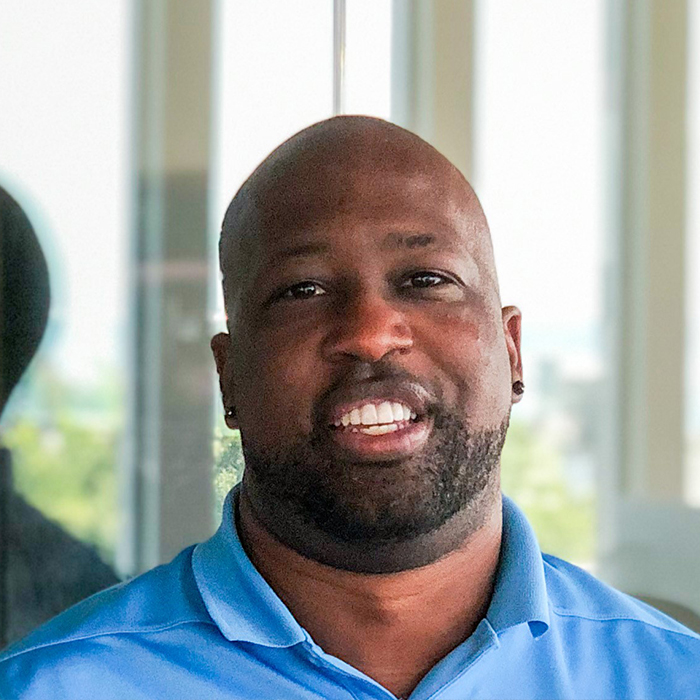 Safety Director
Safety Director
Howard S. Wright (a Balfour Beatty company)
Seattle, Washington
As the Safety Director at Howard S. Wright, Dwayne manages the largest safety team out of all the U.S divisions of Balfour Beatty. He started at the company in February 2020 and moved into the role of Safety Director in June 2020, and in a short period of time, was able to implement policies and procedures that effectively keep teams safe and healthy.
Dwayne protected Howard S. Wright’s construction sites during riots in Seattle, and he proactively prepared the firm’s project teams for the extreme air pollution from the forest fires in the south of Washington.
Dwayne has over a decade of experience in the realm of health and safety. He was the Health and Safety Manager at Parsons Corporation, then moved on to Odebrecht Construction as the Senior Environmental Health Safety Manager Transportation Sector. He also served as Senior Manager for Environment Health Safety at Balfour Beatty US before moving to Howard S. Wright (also a Balfour Beatty company).
When he’s not upholding health and safety policies, you’ll likely see Dwayne mentoring his team. His colleagues appreciate Dwayne’s leadership and the fact that he makes time for each team member despite having such a busy schedule.
There’s no doubt about it: when it comes to health and safety, Dwayne’s reputation is something to admire.
“Dwayne has transformed the safety team. He supports each individual and promotes self-improvement. He’s a natural leader and mentor. Although he expects a lot, he always makes time for team building events and outings.”
 Director, Electrical Contracting
Director, Electrical Contracting
Huston Electric
Lafayette, Indiana, USA
Brady proudly heads up the Electrical Contracting division of Huston Electric after starting as an intern ten years prior. He is applauded for continuing to push the envelope by taking an 80-year-old family-owned, electrical contracting business to the next level.
After coming back from a 2012 NECA show in Las Vegas, Brady saw incredible potential to deploy prefabrication technology in Huston’s operations. By integrating prefabrication and reworking the systems over the next several years, Huston was able to take back a great share of the multi-family, institutional dorm work over the last five years. This would not have been possible with Brady’s tenacity for innovation.
He has proven himself an asset and now runs a group of a dozen project managers and estimators across three office locations in Central Indiana. The technology he’s brought into Huston has been instrumental to the company’s success and is something they continue to develop and improve upon every day.
“Brady is a strong team member, a great leader, and ambassador for the next generation of Huston Electric. This will continue into the future as [he] is always looking for new ways to get better.”
 Senior BIM Manager
Senior BIM Manager
ISG
London, United Kingdom
Yoanna is a Senior BIM Manager at ISG. She’s part of a large in-house team that combines digital technology expertise with specialist built environment knowledge to optimise efficiencies across the lifecycle of construction and fit-out projects. Her MSc studies in Construction Project management have reinforced her strategic thought process in delivering above expectation and her understanding and importance of DfMA (pre-fabrication).
Yoanna is highly regarded for her ability to actively engage individuals at all levels of the business, sharing best practice solutions and tools that consistently drive ISG forward as a technology-led contractor. An Architectural Technology and Construction Management graduate from VIA University College, Yoanna utilises her previous consultant and main contractor experience to great effect as a champion of operational efficiency at every stage of the project process.
“Yoanna’s impact has been infectious to the point of teams requesting her on projects. A true integrator of people and technology.”
 Managing Principal
Managing Principal
KEi Architects
Charlotte, North Carolina
When Marcus joined KEi Architects in 2019, the firm was already quite successful and had a reputation for being an award-winning, client-driven practice. Under his leadership, KEi Architects started gaining traction in new segments and localities, beginning to reshape the firms image.
Over the past fiscal year, Marcus secured projects that have required KEi to rethink how the firm produces, coordinates, and delivers professional services. He understands the value of his team and continually explores opportunities to leverage technology that will help them continue to perform at high levels.
Marcus strives to put the firm in the best position for growth by developing the company’s strategy, policy, core values, and long-term goals. He oversees KEI’s offices, maintains quality controls, and coordinates with the company’s officers to ensure profitability. Marcus coordinates KEi’s marketing strategy and sees to it that the firm is able to capitalize on opportunities for growth and marketplace expansion.
The fact that Marcus was able to achieve so much for KEi Architects in a short period shows how talent, when combined with drive, gets impressive results.
“Marcus’s acumen for business development and project delivery is beyond his years. This has begun to show in the types of projects the firm is involved with and the high caliber of his teams.”
 BIM Manager
BIM Manager
KEO International Consultants
United Arab Emirates
As BIM Manager at KEO International Consultants, Ahmad supports the company’s BIM teams and ensures that projects are delivered on time and according to KEO’s vision and digital strategy. He takes charge of the BIM task force and sees to it that VDC technologies are implemented consistently and adhere to the company’s BIM roadmap.
The people who work with Ahmad will tell you that he constantly pursues innovation and promotes design excellence, high standards, and delivery quality in everything he does.
Thanks to him, KEO’s processes, standards, and procedures are tightly aligned and unified. In fact, the company’s ISO 19650 kitemark certificate by BSI demonstrates this, and Ahmad played a significant role in its implementation and audit process.
It’s also worth mentioning that keeping KEO’s teams aligned is no easy feat, considering that the company has offices in 7 cities, 6 countries, and 2 continents. Not only that, but the firm collaborates with partners, clients, and consultants from all over the world. Under Ahmad’s guidance with verifying and administrating the right permissions, the company can ensure that stakeholders can access the necessary information and coordinate with one another.
Simply put, Ahmad is doing amazing things for his firm, and the results speak for themselves.
“Ahmad is a highly committed and hard working person who is leading a team of 180+ people in the implementation and management of BIM. He is helping our teams and clients by taking them from inspiration, through conceptualization to realization of planning, design and project delivery.”
 Technology & Innovation
Technology & Innovation
Khatib & Alami
Egypt
Amira looks after Technology & Innovation for Khatib & Alami, a multidisciplinary urban and regional planning, architectural and engineering consulting company.
She helped develop an auditing system that can monitor modeling quality issues automatically, thus streamlining the process for the teams at the firm. She also contributed to generative design approaches, which enabled the team to mass-produce models.
Amira also develops and implements technology to improve collaboration and information exchanges for BIM projects at Khatib & Alami. She’s someone with extensive knowledge of computer languages, and she uses that know-how to improve modeling approaches.
Because of her standout work, Amira was assigned to handle the process for all Khatib & Alami design centers—spread across three different countries in the Middle East and North Africa.
“Amira’s forward-thinking nature and passion for innovation helps Khatib & Alami work efficiently and deliver superior outcomes. By developing plug-ins, macros, and stand-alone programs, Amira is using innovative solutions for BIM and engineering disciplines.”
 Senior BIM/VDC Engineer Manager
Senior BIM/VDC Engineer Manager
Largo Concrete, Inc.
Tustin, California
Yesenia is a Senior BIM/VDC Engineer Manager for Largo Concrete, Inc., one of the nation’s largest structural concrete contractors with over $600,000,000 in annual revenues with several offices in the United States.
She plays a pivotal role in the preconstruction process. In this position she works closely with the field teams and project executives. Yesenia’s role is to build computer models of the concrete frame that is to be constructed in order to minimize risks and issues before breaking ground.
She has an uncanny ability to dissect complex design documents and to provide clear construction details to the field supervisors. Yesenia’s efforts also enable the team to identify conflicts, mistakes, and potential problems. She coordinates the architectural, structural, and civil drawings. She submits clarification requests for the information that is lacking or where the design drawings are in conflict. Yesenia then works closely with the field teams to ensure they understand precisely how to use the Concrete Models of what they are to build.
Yesenia has helped Largo Concrete improve the level of service we provide to our customers, and this, in turn, has led to our continued growth. With Yesenia’s help, the teams at Largo Concrete are able to make decisions with greater confidence, increase production, and improve the quality of their work.
“Yesenia makes your job easier—and more successful—when she is part of your team.”
 Senior Superintendent
Senior Superintendent
Ledcor Construction Limited
Toronto, Ontario
Jessica is a skilled and experienced construction pro. In her role as Senior Superintendent at Ledcor Construction, she’s taking charge of an approximately $400 million project on airport grounds, coordinating with trades on site, while leading teams of her own.
She’s adept at identifying and resolving inefficiencies in construction processes and procedures and offers solutions to consultants and owners to improve design issues. Jessica also uses the latest technology to keep projects up to date, ensuring that Ledcor keeps up with industry demands.
Jessica’s colleagues also commend her management style. She leads all her projects with enthusiasm and a smile that encourages collaboration and keeps everyone motivated. When faced with stressful or difficult situations, Jessica is able to remain calm, thus helping teams find solutions quickly. In addition, she never fails to lift others up and promotes constant learning to all her staff.
Before joining Ledcor, Jessica served as Superintendent at Turner Construction Company. Prior to this role, she was Assistant Superintendent at EllisDon for five years.
Jessica’s superintendent skills, combined with her strong leadership abilities make her a fantastic addition to any AEC team.
“Jessica has the skill of bringing our team together and bringing the best out of us.”
 Project Solutions Executive
Project Solutions Executive
Messer Construction
Cincinnati, Ohio, US
As the Project Solutions Executive for Messer Construction, Brant is hailed for his exceptional leadership, training capabilities, and rapid implementation of a massive, company-wide technology adoption.
In February of 2021, Brant started a pilot program for Messer to start using Autodesk Build. In an effort to get Messer and its clients onboarded with the new technology, Brant led an extremely in-depth “teardown” of the construction software to expedite the evaluation process. Within about 48 hours of sending his findings to colleagues, he had received pages and pages of feedback which would inform the company’s approach to adoption of key construction technologies. He even developed a grading scale to compare Messer’s current tools against popular market options.
Once the tools were graded, Brant had a good understanding of what Messer needed. He assembled a committee of 20 of the company’s top employees from all over the US, for a week-long in-depth look at all the tools to get direct feedback.
As a result of Brant’s research and rigorous QA/QC, Messer went ahead with a full company rollout of the committee’s recommended construction technologies across $1.6 billion in projects that started in June of 2021.
The Messer team now relies on Brant as the primary contact internally and externally for all questions, concerns, and feedback regarding Autodesk Build. He also leads training and onboarding for all new projects using the tool. His eye for detail and ability to inspire technology adoption is appreciated by his colleagues, the firm’s customers, and industry peers.
“In all my years, I have never been a part of such a well-organized, comprehensive, and effective evaluation. I’ve seen $50m GC’s struggle with this. Brant is an industry pioneer who has implemented or managed technology with a major impact on a project and their company.”
 Virtual Construction Lead – Civil
Virtual Construction Lead – Civil
Miron Construction Co., Inc.
Neenah, Wisconsin
Jay Mathes has a unique combination of an engineering background, project management experience, and a drive and passion for BIM. This unique combination is noticed by his Virtual Construction team as well as the craftspeople in the field. In his role as the Virtual Construction Lead – Civil at Miron Construction Co., Inc., Jay leads by example, helps establish best practices, manages workflows, and is continuously researching new technologies.
He recently led the BIM coordination on a large healthcare project that involved prefabricated MEP rack systems—a first for many of our partners. As a result of Jay’s leadership, the BIM coordination was completed and the prefabricated racks were installed with no issues, which saved the project considerable time and effort.
Jay is also a champion of construction technology, and he uses innovative tools to tackle various challenges at Miron. For example, he was part of an IPD project for a large healthcare client in Wisconsin. This project demanded an impossible timeline and extensive upfront coordination between the design and construction teams. Because of Jay’s efforts and utilization of technology, the project was not only completed in time, but considered a major success.
Because of his work ethic, drive, and leadership abilities, his teams have quickly identified Jay as an industry leader. Jay has become the “go-to VDC guy” for many of Miron’s high profile clients such as the Green Bay Packers, Fincantieri, and ThedaCare.
“Jay’s leadership has helped establish Miron’s Virtual Construction team as a pioneer in Wisconsin and the Midwest as it relates to VDC. He is continuously pushing the envelope when it comes to construction technologies.”
 Associate, Practice BIM Manager
Associate, Practice BIM Manager
O’Mahony Pike Architects
Dublin, Ireland
At O’Mahony Pike Architects, Eoin is considered the point person for implementation of BIM in recent years. Not only has he helped roll out the technology, but he sees to it that the firm stays up to date with the latest BIM standards and digital technologies.
Aside from leading a team of BIM Coordinators, Eoin empowers the entire team to adopt the right workflows to increase efficiencies across the variety of project types within the company.
Eoin’s work transcends the four walls of O’Mahony Pike Architects; the things that he has accomplished have influenced the industry in general. He’s a member of the Royal Institute of Architects of Ireland’s BIM subcommittee and has been a key person involved with standardizing BIM processes across the country.
Eoin’s colleagues also credit him for helping O’Mahony Pike Architects navigate the pandemic. He implemented cloud-based technology across the firm, allowing projects to move to the cloud immediately. Thanks to him, the company was able to streamline its processes throughout the entire project lifecycle.
Eoin has clearly added tremendous value through his work. As long as there are people like him, the AEC industry will continue to make strides in construction tech.
“Eoin has been the main person responsible for the implementation of BIM over the last few years and ensures that the company always remains up-to-date with the latest BIM standards and digital technologies. Aside from this, he is extremely professional, patient, and kind. Overall, is a wonderful person to work with.”
 Technology & Innovation Lead
Technology & Innovation Lead
Obayashi Corporation
Tokyo, Japan
Ryuji is the Technology & Innovation Lead for Obayashi Corporation. Ryuji has been with Obayashi Corporation for over 15 years and has a deep understanding of BIM and the construction industry. His skillset covers various disciplines, including design, architecture, and software development.
BIM modeling, which involves huge amounts of data, requires strict rules for element classification. He built a classification process as a BIM modeling solution in which the elements are gradually subdivided over time. Thanks to his contribution, Obayashi Corporation’s BIM runs as a BIM which is easy to change and from which data can always be extracted.
On the other hand, one of the challenges that arise in the use of BIM is to ensure that the correctness of the information contained in the model is conveyed. To solve this problem, Ryuji devised a way to integrate Level of Development management into the modeling process and succeeded in its systematization. This system enables accurate and rational communication to confirm the correctness of input information.
Obayashi Corporation released this system as “Smart BIM Connection” in 2021 with the conviction that it would help all BIM users.
Ryuji unveiled this concept at Autodesk University 2020 and won the Top Speaker Award in the On-Demand Video Session APAC Region.
He is also learning data management skills in manufacturing industries such as Bill of Materials (BOM) and Product Lifecycle Management (PLM), and one of his goals is to redefine BIM from a broad perspective.
“Ryuji is a rare person, with a perspective that embodies the benefits that BIM brings to the construction industry.”
 Digital Integration Manager
Digital Integration Manager
Omicron
Vancouver, British Columbia
Karina is the Digital Integration Manager for Omicron where she facilitates the firm’s digital transformation initiatives. When Omicron’s CEO challenged the company to embrace technology in 2018, she more than rose to the challenge.
She helped digitize the firm’s practices by overseeing the rollout of technology to support adoption by the entire team. With her steady guidance, everyone from both the office and field had a single source of truth for project data, as well as tools to manage costs, budgets, and schedules.
Karina also handled the cultural changes required in digital transformation. She stepped up as an advocate and liaison between leadership and business units. She would provide ongoing support and training on technology to ensure that everyone is on board any time changes are made. This involved process groups and technical deep dives, governance committees, and business case development.
In addition, Karina made sure that everything the team did was measurable. She identified the right performance metrics and used BI and analytics tools that gave the team access to information about KPIs and project updates. She then leveraged the development of Omicron KPIs to win work through business development efforts.
Karina and the Omicron team have worked on high-profile projects all over western Canada. A few noteworthy jobs include The James at Harbour Tours, The SAP “Remainland” Project at SAP Vancouver, First West Credit Union Head Office, Molson Coors Fraser Valley Brewery and more.
Her ability to develop and execute measurable digital transformation initiatives is admirable and there’s no question that she’s an asset to any team.
“Karina’s passion is in how things get done. She has been instrumental in transforming the way Omicron designs, develops, and builds.”
 VDC Manager
VDC Manager
Pankow Builders
San Francisco, California
As VDC Manager at Pankow Builders, Lou works to improve the company’s coordination and issue tracing procedures. His work has made a significant impact on numerous big-ticket projects, including the San Francisco Conservatory of Music, 1951 Harbor Bay Parkway in Alameda, 500 Broadway in Santa Monica, Los Angeles Mission College in Sylmar, and 550 O’Farrell in San Francisco.
One example in which Lou’s work shines can be seen in the San Francisco Conservatory of Music project, which involved collaboration between Mark Cavagnero Associates and the Pankow Builders. The teams had to deal with challenging constraints, and overcoming them required close coordination between all members of the design and construction teams.
Lou’s efforts in improving the coordination process enabled the team to identify and resolve over 850 constructability issues ensuring that the design would fit, function, and meet the design intent set forth by the Cavagnero team. Nevermind the avoidance of costly rework down the road. The BIM coordination process allowed the team to prefabricate many of the larger MEP systems from the model ensuring better accuracy and a more efficient install.
Because of Lou’s commitment to improving processes in the company—and the industry as a whole—the teams he works with, and the projects they tackle, are incredibly successful.
“Lou demonstrates a commitment to improve the industry by searching for better ways to design and build. He is not satisfied by the status quo, he leans on innovation to help tackle some of the industry’s biggest challenges during design and coordination”.
 Associate Civil Engineer
Associate Civil Engineer
Phoenix Civil Engineering, Inc
Santa Paula, California
Sarah is an Associate Civil Engineer at Phoenix Civil Engineering, where she develops project plans for a wide range of jobs, including water and wastewater infrastructure, road improvement, stormwater management, agricultural facilities, and more. She’s well-versed in construction management and site inspection. She’s also skilled in design optimization, value engineering, and cost estimating.
As part of a small office, Sarah is engaged in all aspects of Phoenix’s civil engineering projects from design to construction observation. People love working with Sarah because she’s supportive and dependable. She’s an astute field engineer and team members can rely on her to work with contractors and make real-time field decisions.
When she’s on the field, Sarah doesn’t hesitate to share her ideas on how to streamline processes and communication between the site and office teams.
And when the company decided to adopt a new project management platform, Sarah stepped up to test the program and ensured that it worked well for Phoenix Civil Engineering. She is a true team player and makes life easier for everyone she works with.
“Sarah is never afraid of getting her hands dirty or tackling a new challenge. Sarah exhibits professionalism and confidence while in the field and has earned the respect of the construction teams she has worked with. Not only is she a great engineer, but she is also friendly, welcoming and vibrant.”
 Operations Leader
Operations Leader
Precision Precast Erectors, LLC
Post Falls, Idaho
Caleb is an inspiring example of someone who has worked their way to the top. Throughout his AEC journey, Caleb continues to demonstrate admirable values in the form of strong leadership, hard work, and resilience.
His first job included hands-on labor for an architectural sheet metal fabrication company. He also received mechanical experience working with CNC machinery doing maintenance repairs, swapping out parts, and ensuring the equipment ran smoothly.
In 2012, he was hired at Precision Precast Erectors (PPE), where he joined the Local 14 Ironworkers Apprenticeship Program and became a journeyman steelworker.
Caleb continued to add to his skill set by learning how to successfully manage projects and people. In 2015, he realized the importance of technology in construction and developed PPE’s IT initiative. The firm started adopting various construction software, and Caleb oversaw the use of these programs for various projects.
Because of his accomplishments, Caleb was promoted to a General Superintendent position, and then to Operations Manager a year later. Today, his responsibilities include project planning and scheduling, as well as collaborating with GCs, clients, and suppliers to ensure that projects are all completed on time and within budget.
Caleb also demonstrated strong, and much-needed leadership skills amidst the pandemic. He implemented various procedures that enabled teams to work remotely with minimal disruption. And for those who had to come into the office, they were able to do so safely, thanks to Caleb’s guidance.
Fast forward to 2021, and PPE continues to thrive—with many thanks to Caleb’s meaningful contributions.
“Caleb’s work ethic is noticed by all employees, and they recognize that Caleb values their time. He truly leads with a servant’s heart.”
 Project Execution Lead
Project Execution Lead
Sanergy
Nairobi, Kenya
Matthieu is a Project Execution Lead at Sanergy, an insightful and promising organisation in Kenya providing sanitation and waste management solutions for these booming cities. There he empowers his colleagues to embrace innovation by championing, training, and upskilling users on construction solutions. His colleagues praise his ability to read the room and nurture relationships that foster success.
As a result of his hard work and intuition, the teams at Sanergy are able to collaborate more effectively with much smoother processes.
Matthieu’s construction education and career have taken him all over the world. From his engineering school ESTP in Paris to his first internship as a Production and Process Engineer at the Canadian company Lassonde Inc. in Montreal, and followed by a Site Foreman Trainee role at Colas, a road construction firm in France. He then worked as a Safety Department Research Assistant at the University of Colorado at Boulder, where he studied his Master of Science in Civil Engineering and Management.
After graduating in 2014, he moved to Kuala Lumpur, Malaysia, to take on his first managerial role in Safety, Quality, Environment for 2 years within VINCI Construction before moving back to France to develop an Operational Excellence branch within the same company.
In 2021, he moved again to Nairobi, Kenya this time to start working as the Project Execution Lead at Sanergy.
Matthieu’s diverse and global experience has allowed the development of high-value people skills—ones that enable personal and professional prosperity.
“Matthieu takes on construction challenges head-on without fear, making use of tools available to him to ensure quality, safety, and performance.”
 Vice President – Preconstruction
Vice President – Preconstruction
Skanska USA
Durham, North Carolina
Will is the epitome of being data-driven in construction. He invested heavily in the continuous development and improvement of Skanska Metriks, the company’s proprietary benchmarking tool, which has driven analytical insights to improve cost certainty for clients and facilitated enhanced collaboration with our design partners.
Metriks arms teams with the data they need to fully understand projects, enhancing their ability to find value added solutions and optimize designs. It also helps teams develop with more accurate estimates by drawing insights from detailed data on similar historical projects. Will understood just how valuable the tool could be for Skanska, and he championed it’s development and use within the company.
He is a true early adopter, not just with technology, but also when it comes to finding creative approaches to the same old problems. According to his colleagues, he quickly becomes a “superuser” of new techniques, and walks his team through the integration process to ensure they are comfortable and set up to succeed.
He also excels in leadership roles. He prioritizes his staff’s wellbeing and goes out of his way to check on each individual to ensure they’re happy, engaged, and understand the value and purpose of their day-to-day efforts. A simple thing, and because of this, Will has garnered widespread respect among the teams that he works with.
“Will has been an impactful and driving force. He uses data and new technology adoption to improve workflows, and adds value for clients in areas such as enhanced cost certainty.”
 Head of Innovation
Head of Innovation
SSOE Group
Detroit, Michigan
As Head of Innovation at SSOE Group, Mark has organized, delegated, and tracked the firm’s digital transformation initiatives.
Most notably, he led a team of AEC practitioners through a massive change management and process improvement. This was no easy feat, as it involved upending legacy methods and bringing 1,100 engineers, architects, designers, and clients into a digital platform—and the effort was worth it. It gave SSOE a more transparent and data-rich environment that everyone now benefits from.
Beyond this, Mark also implemented advanced Reality Capture practices into the company’s BIM environments. Over 50% of SSOE’s projects involve renovation, so Mark’s initiatives have transformed the company’s deliverables, advanced output quality, and expedited complex project schedules. The work of the many passionate change agents across the SSOE organization, along with Mark’s technical creativity, has sped up the process of using Reality Data in new and exciting ways for our clients. This has led the teams to work with several leading technology solution providers in the reality capture space to bring best practices and cutting edge solutions to market faster than our competition.
While other companies spent time remodeling scan data, Mark aggressively capitalized on speed, quality, and technology integration, thus delivering a better experience to the firm’s clients. Today, Reality Data is a key component in many of SSOE clients’ Digital Twin experiences and redefining deliverables required to accelerate start-up of new production lines.
“Mark’s commitment to advancing technology, people, and process is unparalleled in the industry.”
 Director of Special Projects
Director of Special Projects
Swinerton
Atlanta, Georgia
Derek Mosiman is the Director of Special Projects at Swinerton, a general contractor that provides commercial construction and management services throughout the United States. He champions the use of innovative technology in construction as a way to increase value for clients and is always looking for ways to improve processes and gain operational efficiencies. Starting with Swinerton as a Project Engineer over eleven years ago, Derek’s strong leadership, focus on accountability, and forward-thinking attitude have positioned him well as Director of Special Projects.
A key accomplishment for Derek over the last several years has been leading Swinerton’s Atlanta Division towards greater market diversity. As a result the team has experienced significant growth and has expanded its reach to include corporate interiors, aviation, healthcare, industrial, hospitality, multifamily, commercial office, and senior living.
A proven leader and innovator, Derek has made his mark on Swinerton, and he’ll undoubtedly continue to accomplish great things in the future.
“We are a young group that’s constantly inspired by Derek’s leadership and work ethic. He challenges and empowers us to be better versions of ourselves every day and we are grateful for it.”
 Superintendent / Regional Safety Manager
Superintendent / Regional Safety Manager
The Neenan Company
Fort Collins, Colorado
Tim goes above and beyond his role as Superintendent and Regional Safety Manager at The Neenan Company. In addition to running day-to-day operations on construction projects, Tim strives to be an advocate for training and technology adoption.
He set up learning paths for field staff through LinkedIn Learning and helped establish the firm’s drone program by becoming Neenan’s first FAA-licensed Unmanned Aircraft System (UAS) pilot—something that would allow him to better leverage drones for the company’s projects. On top of that, he participated in document control subcommittees, took an active role in the safety department, and trained the field staff on the use of Trimble robotic total stations.
He also advocated for standardization across projects with the use of technology, thus improving efficiency across the organization.
Tim continued to shine throughout the pandemic. He implemented better ways to communicate and ensured that the company’s processes were consistent. He helped transition the firm away from disconnected systems, instead implementing a platform to improve collaboration across the different business units.
As a result of Tim’s hard work, The Neenan Company’s teams are able to work more productively and deliver stronger outcomes.
“Tim has gone the extra mile to take his knowledge from the field, and work across disciplines, to help our company grow.”
 Director of Electrical Construction
Director of Electrical Construction
The Tri-M Group, LLC
Kennett Square, Pennsylvania
Marcus is currently the Director of Electrical Construction at The Tri-M Group, a firm that has been providing electrical and facility solutions for more than 50 years. In his role, Marcus has helped Tri-M streamline its construction operations, manpower efforts, and prefabrication production. Thanks to his efforts, the company’s estimating team can now work more cohesively.
Marcus also spearheaded the firm’s technology adoption, helping Tri-M migrate its drawing management system to more advanced construction platforms. Thanks to his passion for establishing efficient techniques and processes, the teams at Tri-M are able to be more data-driven and collaborative across an entire project lifecycle, from estimating to closeout.
He has been with the company for over five years. Prior to Tri-M, Marcus was an Electrical Engineer and Project Manager at Electrical Design Build Inc. He has a Bachelor of Science in Electrical and Electronics Engineering from Temple University.
More than just an AEC professional, Marcus is an excellent leader with a strong drive to improve and innovate.
“Marcus’ data-driven approach and appreciation for the future of the construction industry has positioned Tri-M to be a leader moving forward.”
 Senior BIM and Construction Technology Manager
Senior BIM and Construction Technology Manager
The Walsh Group
Pittsburgh, Pennsylvania
As Senior BIM and Construction Technology Manager at The Walsh Group, Adam oversees the company’s National Building Group – Federal East division working on close $1B worth of current projects in various stages of design and construction up and down the east coast. Aside from leading a team of his own, he makes it a point to assist and educate members outside of his division to help elevate their knowledge and skill sets. With a passion for teaching, Adam strives to expand BIM and construction technology solutions to everyone at his company and encourage best practices throughout the industry.
With over 17 years in the AEC industry, Adam has a background in Architecture from Alfred State College. Adam spent the first part of his career working for 3di Architecture, who were the second firm in Buffalo NY to adopt Revit as their main design tool, before making the move to the construction side with The Walsh Group for the last 10 years. At Walsh, Adam started off as an on-site field BIM expert on the $120M Iowa State Penitentiary project, where he coordinated 12 buildings and led the team to deliver an LOD500 Facilities Management BIM.
Since then Adam moved to an office management role and became the Sr. Construction Technology Manager for his group. He has worked on numerous projects for both public and private clients with similar high level BIM to FM deliverables, and is an expert at various BIM data requirements including COBie, eOMSI, FAA, and USACE BIM standards. Additional notable projects include American Greetings Headquarters in Cleveland, Charlotte NC Air Traffic Control Tower, C-17 Hangar for Pittsburgh Air Force Reserve, along with many other offices, mixed-use developments, schools, aircraft hangars, and other DOD facilities.
Spearheading the implementation of construction technologies for his group, Adam led his team to early adoption of many common tools such as Revit cloud collaboration, cloud-based model coordination solutions, and all other tools now included in the Autodesk Construction Cloud. Implementing Revit models in the cloud 7 years ago became an integral part of how his team operates and communicates across the country. Using Revit and BIM 360 Collaboration, connecting the Pittsburgh office to job sites and other offices all over the east coast, was already standard operating procedure for Adam and his group; so when the pandemic hit last year, his team did not miss a beat and were able to work from anywhere.
Adam also focuses on the importance of the “I” in BIM, and has transformed that passion for information into leveraging data analytics to help manage, maintain and audit projects. Because of this, Adam’s team is able to meaningfully increase the productivity, quality and safety of its projects while providing his clients exceptional services.
Adam’s dedication and work ethic shine in everything he does, and this makes him an excellent addition to this year’s 40 Under 40 list.
“Adam is a relentless pioneer in the BIM/VDC space. He constantly seeks to understand, develop and improve industry standards as well as educate and enable those around him to be better equipped for the future of the industry.”
 Vice President and Director of Digital Design
Vice President and Director of Digital Design
Thornton Tomasetti
Seattle, Washington
Kristopher is VP and Director of Digital Design at Thornton Tomasetti, where he leads a team that’s charged with improving BIM workflows across the company’s 40+ offices.
Colleagues applaud Kristopher and his team for delivering on two major standardization efforts: design documentation standards and data integration standards. The former simplifies the day-to-day tasks of Thornton Tomasetti’s designers, while the latter helps the company unlock corporate data and improve data visualization.
In his role, Kristopher also helps direct strategic investments in future technology, ensuring that Thornton Tomasetti stays competitive in the years to come. He coordinates the firm’s research and development group and represents Thornton Tomasetti as a thought leader in external organizations such as the Engineering Executive Council, AISC BIM Guide Development group, and the SEI Digital Design Committee. Kristopher also serves as the BSI technical expert representing the UK.
In addition to his firm-wide technology work, Kristopher has supported major projects including Seattle’s Climate Pledge Arena, where he was responsible for collecting and consolidating laser scans to support the existing building assessment ahead of the $1-billion historic building renovation. Kris also developed a Revit add-in that allowed the geotechnical team to automate the modeling of hundreds of tiebacks in the 3D model to aid in design coordination and construction sequencing.
Kristopher’s leadership was largely felt and appreciated during the pandemic. He advocated for developing solutions that would help the firm’s design teams transition to remote work while continuing to drive progress on key initiatives.
“Kristopher is a key technology leader at Thornton Tomasetti. He leads the Digital Design team that bridges between design practices, corporate information technology, and the CORE research and development group.”
 Director of Preconstruction
Director of Preconstruction
Truebeck Construction
Portland, Oregon
Betsy has an accomplished tenure in the industry, and has risen to Director of Preconstruction ahead of most. As Head of Preconstruction at Truebeck, she and her team have earned the reputation of always providing top-tier preconstruction services. As such, she continues to win projects and grow opportunities in the Portland market.
Aside from overseeing preconstruction at Truebeck, Betsy is a co-leader in the day-to-day operations of the firm’s newest regional construction office in Portland, which has continued to thrive since its opening.
She’s a leader at Truebeck’s internal Women in Construction events and often represents the company at speaking engagements and market events.
Prior to managing Portland, Betsy impressively managed preconstruction for some of the most complex projects in the San Francisco Bay Area. This includes Twitter’s Headquarters in Market Square, Uber’s Mission Bay HQ, and the Alexandria Real Estate Equities Center for Life Science in San Carlos.
With such an impressive work history, Betsy will undoubtedly continue to do great things in the realm of preconstruction. We’re looking forward to seeing what she accomplishes next.
“Betsy has become a well-respected expert in the construction industry, a mentor and coach to a highly effective team, and has worked tirelessly to create more opportunities and benefits for women in the construction industry.”
 Senior Construction Engineer
Senior Construction Engineer
Virginia Department of Transportation
Richmond, Virginia
Dakota serves as a Senior Construction Engineer at the Virginia Department of Transportation (VDOT), where he implements new construction technologies for the organization.
People who work with Dakota will tell you he’s been integral to VDOT’s rollout of their digital initiatives—known internally as eConstruction—over the past four years.
After personally researching and evaluating over two dozen potential solutions for digitizing VDOT’s procedures, he carefully managed several pilot programs across the Commonwealth of Virginia to determine the efficacy of each solution before ultimately working to implement a successful tablet-based inspection program.
Dakota also trained over 450 construction personnel throughout the Commonwealth, both in person and through a series of innovative webinars that walked personnel through the technology.
Aside from his responsibilities around technology implementation, Dakota also works as part of VDOT’s construction divisions project controls and construction management teams. He oversees change order management, contract claims defense, quality assurance audits, and safety and environmental compliance, among other things. He is a graduate of Old Dominion University and earned his Professional Engineering License in the spring of 2021.
Thanks to Dakota’s leadership and deep understanding of construction technology, he’s brought VDOT’s eConstruction program to life while upskilling much of the workforce the program relies on.
“Dakota has been an integral part of the Virginia Department of Transportation’s eConstruction rollout. His leadership has significantly accelerated the delivery of the program.”
Autodesk’s 40 Under 40 Champions of Construction list is so much more than a roundup of admirable AEC professionals. It highlights key insights from respected leaders that, as an industry, we can all learn from.
One of the persistent themes from this year’s class is the importance of education when it comes to construction technology. Investing in technology, and training people how to use it, can do wonders for an organization. It can unlock productivity gains, improve collaboration, and help you deliver better outcomes.
Another key learning? The AEC industry is filled with intelligent, resourceful, and innovative individuals. Many stood against the challenges of this past year and proved to themselves, their companies, and the industry that resilience is alive and well.
That’s a wrap on Autodesk’s 40 Under 40 Champions of Construction 2021! We hope you enjoyed getting to know the individuals on this year’s list. If you’d like to revisit last year’s Construction Champions list, you can do so here.
Subscribe to our newsletter to get the latest construction trends, tips and news, sent straight to your inbox.
The post 40 Under 40: Champions of Construction 2021 appeared first on Digital Builder.